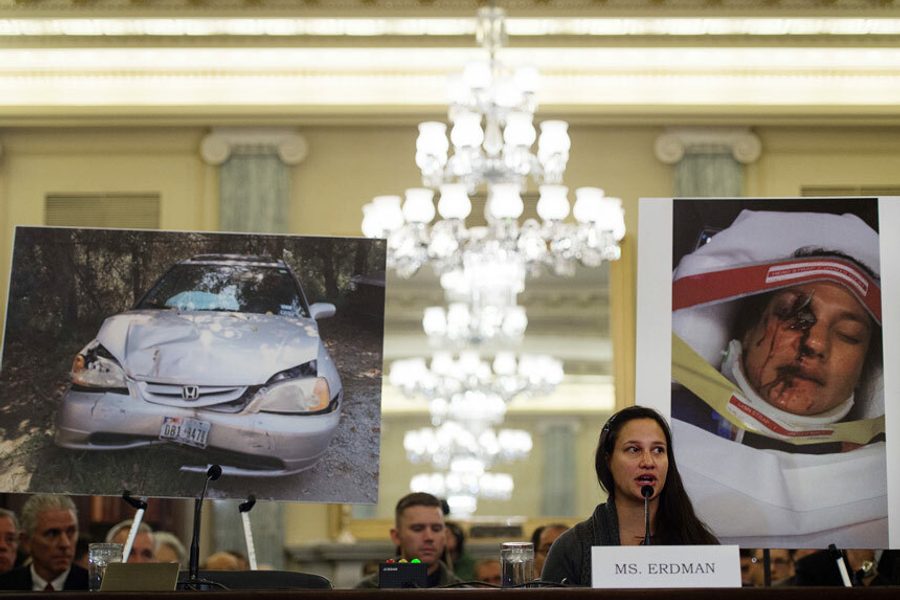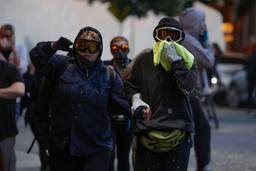Do You Want Shrapnel with That Airbag?
Culpable carmakers and captive regulators make a deadly combo.
Terry J. Allen

How’s this for a job-creation program: Let’s dig a yawning new circle of hell for corporate and bureaucratic decision makers who allowed the sale of flawed, fatal airbag systems. But their eternal lodgings aside, why aren’t the culprits in prison for homicide?
In 2004, when an airbag exploded and shot metal shards into the driver of a Honda, neither the carmaker nor the airbag manufacturer, Takata, sounded an alert, issued a recall or sought the involvement of federal safety regulators, the New York Times reported.
Five years later, in 2009, Ashley Parham, an Oklahoma teen, died after the airbag in her Honda Accord exploded and speared her chest with metal fragments. Although Honda had issued a very limited recall of the airbags in 2008, the carmaker, along with Takata, denied fault and settled with Parham’s family for $5,000. The companies’ decision not to sound the alarm, and to cover up the problem, left other carmakers using Takata airbags unaware of possible defects for years. And it left drivers playing Russian roulette with a device armed with the same explosive Timothy McVeigh used to blow up the Federal Building in Oklahoma City.
If the auto industry’s reaction to the danger had the slow-motion lethargy of a nightmare, that of the National Highway Traffic Safety Administration (NHTSA) was nearly comatose. The federal agency responsible for vehicle safety had received complaints about exploding airbags as early as 2000, but didn’t open its first investigation until 2009. Then, in “a timetable so swift that it appears to have taken even Takata by surprise,” it closed the inquiry after six months, according to the Times. NHTSA concluded, “there are no additional vehicles to be investigated.”
By 2014, an undeniable trail of bloody dots led back to Takata and the 11 U.S., German and Japanese firms that had equipped 37.8 million vehicles with dangerous airbag inflators and propellants. Finally, this year, under mounting congressional, public and media pressure, NHTSA opened a second investigation, and “urged” a nationwide recall. On December 2, testifying before a House committee, Takata refused. A week later, Honda announced an expanded “investigative” recall that would include 19 million Takata airbag-equipped cars around the world.
NHTSA’s response to Takata’s refusal to implement its own recall was “disappointment.” With that level of regulatory zeal, it is no wonder NHTSA didn’t challenge Takata’s claim that the errors causing the explosions were fixable and not systemic. It was left to the media to reveal the fact that, starting in 2001, Takata had switched to a cheaper propellant — ammonium nitrate — which deteriorates and is impaired by moisture and changes in temperature.
The propellant’s explosive potential and instability also raise the serious, and seriously under-reported, issue of the U.S. market in used airbags. Recyclers, aka junkyards, “retrieve never-deployed airbags from scrapped autos and sell them as replacement parts to collision repair shops,” notes Edmunds.com, an online auto resource. “It’s perfectly legal — and, critics say, very dangerous.” If these undeployed airbags were exposed to rain after an accident or sat in a junkyard car with a blown-out windshield, they may be useless or hazardous. And with no laws governing how used airbags must be stored, tested or installed, consumers are left ignorant of the risk.
The onus is also on consumers when it comes to spotting extremely dangerous counterfeit airbags — authentic-looking down to the logos — that are illegally imported from China.
NHTSA cavalierly “urges vehicle owners and repair professionals to use only certified, original equipment replacement parts.” Its website also notes that the agency “is aware” of counterfeits for 21 automakers and more than 100 models and estimates that tens of thousands of fake bags are on the road. These can fail to deploy or, like legitimate but defective Takata bags, explode and produce “a fireball and forcefully expel metal shrapnel,” a Homeland Security agent testified in court.
Unsafe at any speed
A similar pattern of industry cover-up and regulatory negligence marks another rash of death-by-airbag failures: Since 2001, GM has been aware that defective ignition switches shut down moving vehicles, rendering them hard to control and deactivating their airbags.
“Despite 4,800 consumer complaints and more than 30,000 warranty repairs, GM waited until 2014 to disclose this defect,” a lawsuit by Arizona’s attorney general charged. The recall GM initiated this February affects 2.6 million cars. But it does not include the 5,000 defective switches sold to dealers and parts shops that remain in circulation. And it’s perfectly legal for those businesses not to inform customers about the recall notices.
Since airbags fail for various reasons, establishing causality is essential to finding a fix. Between 2003 and 2012, a total of 303 people died in non-rear impact crashes in which the airbag did not deploy. So far, faulty ignition switches in GM vehicles have been linked to 32 of those deaths, and the toll is rising.
It includes Gene Mikale Erickson, who died in 2004 while riding in a Saturn Ion that veered head-on into a tree. The driver — his girlfriend, Candice Anderson, 21 — survived to become another poignant and uncounted victim of GM’s greed. She was convicted of criminal negligent homicide, fined and sentenced to 260 hours of community service. She was also sentenced to a decade of guilt and the condemnation of Erickson’s family, until a New York Times investigation forced NHTSA to reveal — in an email to Erickson’s mother — that the faulty switch was the real cause of the crash.
Even two years after Erickson’s death, NHTSA was still sloughing off consumers who reported sudden shutdowns. It wrote a complaining GM car owner that “a review of its database…revealed insufficient evidence to warrant opening a safety defect investigation” into the ignition switches.
In March, excoriating the agency for its delay in launching recalls and investigations, Clarence Ditlow, head of the consumer watchdog group Center for Auto Safety, wrote NHTSA chief David Friedman charging that the only way the agency could have failed to see the non-deploying airbags as a defect trend was “if it closed its eyes.”
There are other explanations for the agency’s poor oversight. One is its paltry budget. But more significantly, NHTSA is a captured agency. In 2010 the Washington Post “found 33 former NHTSA officials now playing leading roles in helping carmakers handle federal investigations of auto defects. Many of the former NHTSA employees also work as attorneys and lobbyists for the auto industry.”
An especially unsubtle case is that of David Strickland, Friedman’s predecessor. When Strickland resigned as NHTSA head in December 2013, the CEO of the auto industry trade group Alliance of Automobile Manufacturers lauded him as “an administrator who always kept his door open.”
That door turned out to revolve between the auto industry and the institutions and agencies tasked with regulating it. On the very day in January 2014 that Strickland left NHTSA, the agency announced it would not demand the recall of the 2.7 million Jeep Liberty and Grand Cherokee models whose gas tanks were prone to rupture in rear-end collisions. Instead the agency allowed Chrysler to “fix” just 1.5 million of the SUVs by adding a trailer hitch — a cheap, partial repair that was unproven and, some experts charged, increased the danger. Chrysler spokesperson Eric Mayne emailed In These Times that the “vehicles are not defective, as supported by our data.” He acknowledged that at least 56 people have died in the fiery crashes; other estimates put the fatalities from ruptured gas tanks at more than 150 victims. As of December 10, Chrysler had “fixed” only 158,266 vehicles.
One month after leaving NHTSA and approving that trailer-hitch deal, Strickland took a new job — at Venable LLC, a law firm that represents various auto industry trade associations and, Consumer Affairs noted, “billed $1.1 million for its services to Chrysler over the last five years.”
Another aficionado of revolving doors is the lawyer representing Takata in the airbag investigations, Ken Weinstein, a former senior NHTSA official.
Airbags save lives, but they are useless when they fail to deploy and ballistic weapons when they explode with shrapnel. If regulators and manufacturers ignore or hide the problem, whether from negligence or greed, they are as culpable in the injuries and deaths that follow as a gunman spraying bullets into a crowd.
In September 2013, Hai Ming Xu, 47, died in the crash of his 2002 Honda Acura. It was only after an autopsy that the Los Angeles county coroner determined he was killed by “a metallic portion” of the airbag inflator that “hit the deceased on the face as it deployed.”
When police first arrived on the crash scene, because of the nature of Xu’s injuries, they had treated his death as a homicide. It was a good call.









